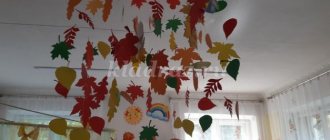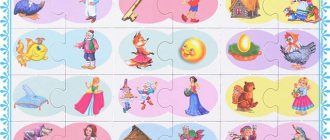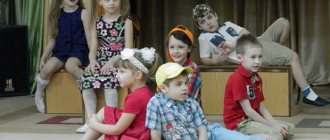Preschoolers
It all starts with several toys learning that they are broken and will not be hung on the Christmas tree this year. Therefore, they decide to escape to the land of New Year's toys - where it is always New Year and they love any toys, even broken ones. (The plot of the book “The Journey of New Year’s Toys” by E. Rakitina)
First of all, the children and I talked and drew a so-called geographical matryoshka doll. We start with the room we are in, then draw a house around it, the house is on the street, the street is in the city of Ramenskoye, and so on. This systemic view structures thinking well: the child understands that each “object” is located inside a more complex object
The map has been drawn and now we need to help the toys find their country. One problem: toys want to travel not in a stuffy box, but in such a way that they can “see everything.” We begin to figure out how to carry the toys so that they can look around. Here are some ideas from children:
- Carry in your hands (minus - your hands will be busy)
- Open the lid of the box (minus - it’s not convenient and can crumble)
- Put it in a bag (This is better, but the toys themselves may break even more)
- Hang it on a stick and carry it on your shoulders (Very interesting solution, we’re trying to implement it, but we also have to hold the stick with our hands)
After the guys examined themselves to look for resources on their clothes and their bodies, even stronger and more interesting solutions began to appear:
- Tie a string to a zipper
- Girls - tie to hair
- Place in your pocket and make small holes “for eyes”
I try to leave variability for such exercises so that children can try any of the invented methods or even use several, rather than trying to push them to ONE answer I have in mind.
- The next task for the children is to mentally travel around your apartment and find all the objects there that DO NOT have components. We have already touched upon the topic of finding what parts an object consists of several times. But it turns out that there are objects such as stone, or chalk, or soap, which seem to have no parts. They themselves are one big part. (Of course, modern children immediately remember atoms and molecules, but these objects really do not have larger parts)
- Wandering in search of our country, the children found a mountain of garbage: lids, candy wrappers, cans. From this stuff, everyone made a new New Year's toy. Learning to use the resources at hand. And as it turns out, garbage is an excellent resource for making jewelry.
- But while we were making all this, a magpie took away one of our toys. To get her to return the toy, you need to come up with funny phrases. We wrote down 3-letter words and then came up with a sentence so that each word in it began with a letter in the sentence:
CANCER - ripe kula k actus TOOTH - green teeth sparkle SCARF - whispers an orange to a red date (Immediately a discussion began that an orange can whisper to a date = ) )
This game is a great way to relax and take a little break from making things up. For preschoolers, such pauses are simply necessary, otherwise they get tired and fall into patterns.
- At the end we found Santa Claus, who told us that there is a land of New Year's toys in every home. This is a Christmas tree on which toys hang and which makes children happy. The children thought a little about how to correct the map they drew at the beginning: it turns out that the “country” ended up in the house!
And then they played with a cardboard Christmas tree, decorating it with small toys.
TRIZ games for five minutes: signs. Week 2
We continue to study and communicate. This week we will continue our conversation on the topic “Signs of objects”, we will conduct observations, experiments, and even show a little trick.
Lesson 6. Signs
Preparation Prepare a bag (you can use a pillowcase) and objects made from different materials: metal, wood, plastic, glass.
Game “Magic Bag” The task is to get only wooden objects (or only metal ones) from the bag. When taking out an object, you need to name one more of its properties.
For your next activity, print out the activity cards. Game “Find a Pair” You are given cards with objects. You need to pair them up. A pair can be based on function (for example, a broom and a dustpan), or a pair can be based on another feature. The main thing is that the child can explain his choice.
Guess riddles about objects. File "Riddles". The child must guess and find it in the room. For kids, use pictures as a guide.
Game “Find an object and shape” You are given cards with an image of an object and cards of a circle, square, triangle. You need to choose the appropriate shape for each item. The game can be made with objects: put different objects in a bag. When taking out an object, the child must match it with the corresponding card.
Lesson 7. Distorting mirror
Preparation Purchase foil cardboard or foil in advance. Activity Mirrors are everywhere, we have them in our house.
Game 1. Find all the objects in the house in which we are reflected. Game 2 Take a spoon and invite the child to look into it. On the convex side the image will be straight, on the concave side it will be inverted. This is a kind of distorting mirror effect. Let the child make this discovery himself.
How Sema and I played in mirrors - here.
Game 3 Let's play with distorting mirrors and make our own distorting mirror. First, we need foil cardboard or foil. Let's bend it so that one side is convex. And the other is concave. That is, it will turn out to be a wave. The distorting mirror is ready. Look into it. You can experiment by folding it either with the convex side or the concave side. The next step is to cut it into squares. Now glue the squares together (not tightly, but so that there is a distance of 0.2 - 0.5 mm between them, we get a kind of mirror made of squares) and we will get another crooked mirror.
Lesson 8. Observations and experience
In the first week we talked about dividing objects into living and non-living. Plants are living. But how do they eat? If you have flowers at home, then your child knows that plants need water to nourish them. Plants create nutrients from water. Let's conduct an experiment that will show how plants drink. Preparation Take Chinese lettuce leaves, a jar of water colored with food coloring.
Experience Color the water, place lettuce leaves in it and wait. The lettuce leaves will color in a few hours.
Lesson 9. Focus.
Today we will surprise the child with a magic trick.
The choice is a wet task - getting a coin without getting your hands wet https://www.youtube.com/watch?v=DLzgkvknmrs Very impressive and simple, we recommend it! Semyon was delighted with this trick. Jumping Coin This is a cute home trick that is simple and effective.
Place a small coin on the table and have someone pick it up without touching the table or the coin. Of course, even if someone volunteers to do this, they still won’t be able to. The secret of the trick: just hold your hand close to the coin and blow strongly on it from a distance of 5 centimeters. The air compressed by your breath will lift the coin and throw it into your hand. This is not possible right away, but after several exercises you can deftly perform this trick: you blow and there is a coin in your hand! Lesson 10. Legs and tails
Preparation Prepare cards with the animals you will play with. You can take animal figurines.
Game 1. Domestic and wild animals. Animals are different. For example, there are wild and domestic ones. Wild ones live in nature, and domestic ones live with humans. You are given cards with animals. The child’s task is to divide animals into domestic and wild ones, to tell about domestic ones, why this animal is needed. You can organize a game of teremok. We are building a house, each animal is knocking on the door, but it is only allowed in if the child tells us why a person needs this animal.
Game 2. Wings, paws, tail. Animals are all different: some run, some fly, etc. They are all amazing. You are given cards with animals - they need to be laid out in front of the child. Another group of cards are questionnaires. We draw one card at a time and the one who guessed the animal takes the card with the animal for himself. The player with the most animals wins. Reflection "Tails". Animals have tails. Why do you think? Let the child think. If he had a tail, what would he want it to be like? Interesting facts about tails: For this wonderful jumper, its tail helps to maintain balance (Kangaroo). On the tail of this representative of the cat family there is a fluffy tassel, and in it a sharp claw (Lion). Its tail is like a whip, it is great for driving away biting insects (cow). Her fluffy red tail flashes cheerfully between the green branches and serves as a parachute for its owner during jumps (squirrel). Her long fluffy tail covers up the traces of her cunning mistress well, especially in the snow (Fox). For this river builder, his tail is both a rudder and an oar, and in it he accumulates fat for the winter (beaver). This feathered healer would have fallen out of the tree in a moment if he had not held on to the trunk with his claws and, of course, his tail, which serves as a support for him (woodpecker). His tail helps him hunt. The blow of its tail is dangerous even for large animals. Covered with horny plates, it is as heavy as a log. With its powerful tail, this animal knocks the victim off his feet, throws him up and catches him with a huge toothy mouth (crocodile). Its head smoothly turns into a tail, there is not even a neck (Snake). This species of primate lost its tail as unnecessary (human)
You can download additional materials from this link.




